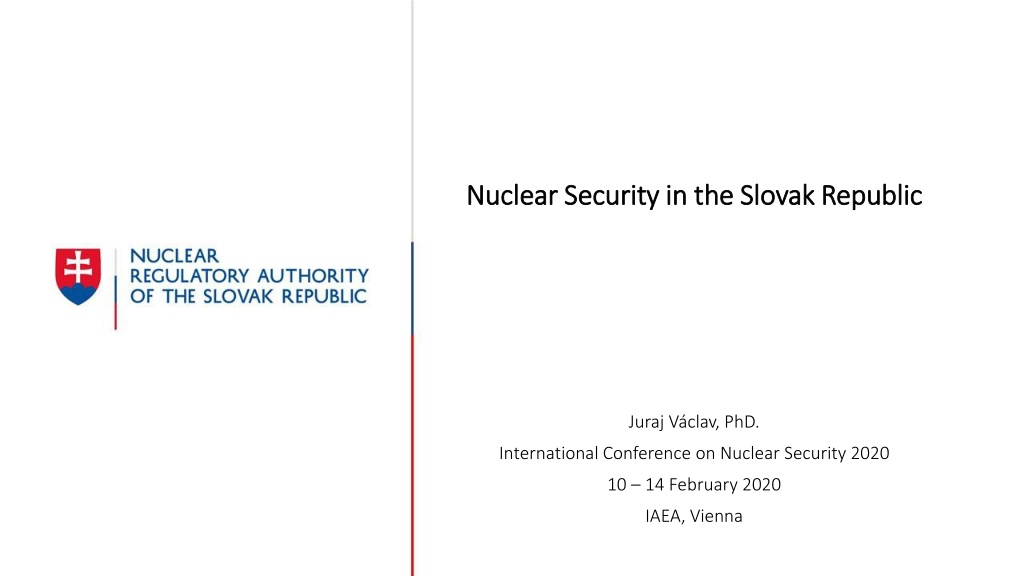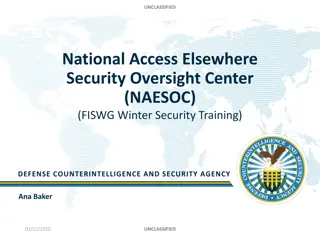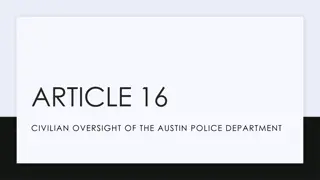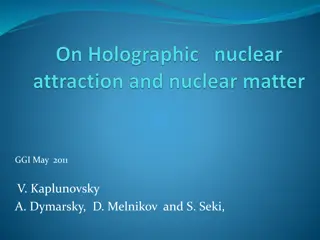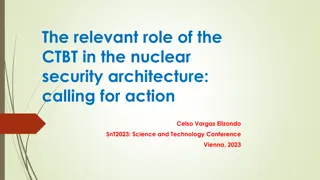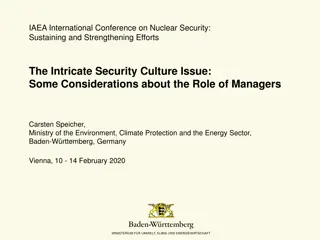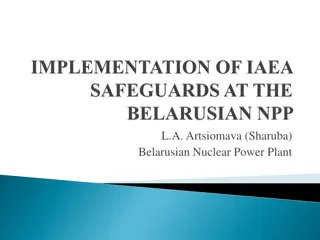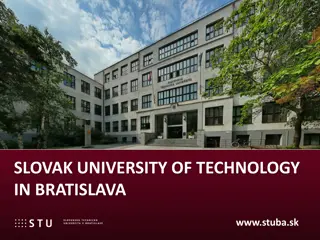Nuclear Security and Regulatory Oversight in the Slovak Republic
The Nuclear Regulatory Authority of the Slovak Republic is addressing new challenges in nuclear security, including threats such as drones and cyber attacks. They are working on updating legislation and implementing countermeasures to safeguard nuclear facilities. The focus is on enhancing cyber security, protecting against physical threats like drone misuse, and planning for potential risks like plane crashes. The authority emphasizes the importance of staying ahead of evolving threats to ensure the safety of nuclear installations in Slovakia.
Download Presentation

Please find below an Image/Link to download the presentation.
The content on the website is provided AS IS for your information and personal use only. It may not be sold, licensed, or shared on other websites without obtaining consent from the author. Download presentation by click this link. If you encounter any issues during the download, it is possible that the publisher has removed the file from their server.
E N D
Presentation Transcript
Nuclear Nuclear Security in Security in the the Slovak Slovak Republic Republic Juraj V clav, PhD. International Conference on Nuclear Security 2020 10 14 February 2020 IAEA, Vienna
2 Nuclear Facilities in Slovakia 26. 9. 2024
3 Regulatory oversight for nuclear security: practices and challenges The Nuclear Regulatory Authority of the Slovak Republic (UJD) is responsible, inter alia, for state supervision upon nuclear safety and physical protection. In recent years we have been facing new challenges and practices, changes in threat environment and new threats have to be taken into consideration, when carrying out our obligations / duties. The nuclear security legislation lags behind the requirements on nuclear security in two to three years. The main reason for this lag lies on one hand in a long and complicated legislative process, on the other hand in rapid changes in requirements for nuclear security. The UJD is at present drafting new legislation which reflects the requirements from the Amendment to CPPNM and also in some new areas. 26. 9. 2024
4 Regulatory oversight for nuclear security: practices and challenges Based on the fundamental principle G the UJD prepares annually state s Threat Assessment and Design Basis Threat. These document reflect besides classic threats also newly arisen threats. The UJD also deals with new views on nuclear security and its interactions mainly with nuclear safety and emergency response and preparedness. One of the most rapidly growing threats is misuse of unmanned aerial vehicles (drones). Drones may be used for several types of malicious acts, for theft, sabotage and also for monitoring of physical protection system and helping the adversaries when performing their tasks. Slovak government established and founded a working group which is responsible for the preparation of countermeasures against the use of drones in critical infrastructure objects and nuclear installations. At present the process of the selection of effective anti-drone systems is underway. 26. 9. 2024
5 Regulatory oversight for nuclear security: practices and challenges Cyber threat represents for nuclear/cyber security one of the most difficult challenges and a dangerous topic. Classic cyber security (administrative systems cyber security, internet security, ) is not sufficient enough to eliminate all the threats faced by nuclear installations today. When planning the cyber threat countermeasures, the operators of nuclear installation in Slovakia focus on three main tasks. The first task is cyber security of physical protection systems itself, the second task is protection of operational and emergency control systems and protection of sensitive information. 26. 9. 2024
6 Regulatory oversight for nuclear security: practices and challenges Protection against plane crash became relevant some years ago. It represents a difficult task for the physical protection system and could be defined as a threat beyond the design basis threat. Two units of the nuclear power plant, under construction at Mochovce site, are equipped with protection of some important systems against intentional attack by small aircraft. The UJD also requires that the planning and design of the project of interim spent fuel storage facility capacity extension is designed against an accidental crash of an airliner, or deliberate attack with an airliner. 26. 9. 2024
7 Regulatory oversight for nuclear security: practices and challenges New threats in nuclear security area have highlighted the issue of the effectiveness of physical protection systems. For the evaluation of physical protection systems, we use SAVI and EASI software. However, this software does not calculate the probability of neutralization of attackers. The UJD has developed a new calculation tool which can perform a calculation of probability of detection as well as probability of neutralization. 26. 9. 2024
8 Regulatory oversight for nuclear security: practices and challenges Physical protection system effectiveness represents technical part of an effective physical protection system. Equally important for the effectiveness of physical protection system is nuclear security culture as a part of organizational culture. The UJD in co-operation with the operators evaluate the level of nuclear security using self-assessment described in IAEA s document NSS No. 28 T, Self-assessment of Nuclear Security Culture in Facilities and Activities. 26. 9. 2024
9 Regulatory oversight for nuclear security: practices and challenges In 2008 it was decided to continue construction of two VVER 440 units at Mochovce site. Construction was interrupted in 2000 due to lack of financial resources. Following the privatization of Slovak Electric Company, the new majority owner, ENEL Company, proceeded to resume construction work with the aim of putting the units into operation in 2012 and 2013. 26. 9. 2024
10 Regulatory oversight for nuclear security: practices and challenges From the beginning of the completion, environmental organizations (Greenpeace, Global 2000, private individuals) began to question UJD's decisions in order to delay or stop the completion of both units and their commissioning. Several legal actions have been brought against UJD and several court hearings with different results have taken place. A common element of most claims was the requirement that UJD should grant applicants access to the safety report. 26. 9. 2024
11 Regulatory oversight for nuclear security: practices and challenges However, as is well known, the safety report contains a detailed description of the nuclear installation, the design, layouts, the location of nuclear materials and radioactive waste, the location and functions of the control and safety systems, and safety analyzes of operational events and emergency situations. From the nuclear security point of view, a safety report can serve as a guide to preparation of theft or sabotage. UJD did not agree with the disclosure of this information and therefore prepared an amendment to the Atomic Act. 26. 9. 2024
12 Regulatory oversight for nuclear security: practices and challenges The Act No. 541/2004 Coll. defines sensitive information in 3: (16) Documentation containing also sensitive information is considered to be a documentation, the disclosure of which could be used to plan or perform activities aimed at causing disruption or destruction of a nuclear installation, and thereby adversely affect the public safety and cause environmental or economic damage. This documentation can be made available to public after removal of sensitive information. (17) Documentation containing also sensitive information means the documentation stated in Annex 1 part A subpar. c), part B subpar. a), b), i), m), part C subpar. a), d), i), j), s), w) and in Annex 2 part A subpar. b), part B subpar. b). 26. 9. 2024
13 Regulatory oversight for nuclear security: practices and challenges Subsequently, UJD prepared a methodology that describes in detail the types of sensitive information, their detailed description and, in particular, how this information can be misused for the preparation of malicious acts against nuclear materials and nuclear facilities. This methodology was used to remove sensitive information in the safety report and such a safety report was provided by the applicant. This demanding activity involving several dozens people for several months (the security report has 130,000 pages in addition to the drawing documentation) resulted in another lawsuit against UJD. 26. 9. 2024
14 Regulatory oversight for nuclear security: practices and challenges UJD disagrees with the disclosure of the safety report because it is aware that the information contained in the safety report could significantly jeopardize nuclear security in the case of misuse. One of the main tasks of UJD is state supervision of compliance with national legislation and international obligations and requirements for ensuring adequate physical protection of nuclear materials and nuclear facilities. Unfortunately, the current legislation, international (Aarhus Convention, Espoo Convention), makes this task very difficult. both domestic and 26. 9. 2024
15 Regulatory oversight for nuclear security: practices and challenges UJD strives to ensure, as far as possible, the highest level of physical protection of nuclear materials and nuclear facilities within the framework of the applicable legislative framework. However, based on many years of experience, we can see that some international legally binding acts are directly contradictory in some areas. 26. 9. 2024
16 Conclusions New threats and new challenges in nuclear security area request also new approaches from regulatory bodies. It is imperative that the regulator responds in a timely manner to the new realities, and it is also necessary to modify the legislation accordingly. All these areas represent challenges for the UJD not only in the area of acquiring new knowledge, but also in the area of working with supervised entities. Often the latter is the biggest challenge for the regulator as well as the operator. The enforcement of changes encounters mainly financial barriers, but the UJD is still able to enforce the necessary changes aimed at increasing the level of physical protection and nuclear security and eliminating emerging threats. 26. 9. 2024
17 Thank Thank you you for for your your attention attention! ! 26. 9. 2024
